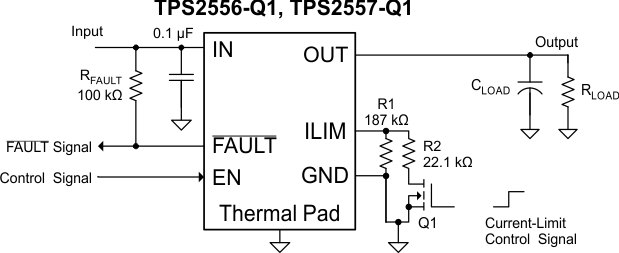SLVSC97B March 2014 – September 2020 TPS2556-Q1 , TPS2557-Q1
PRODUCTION DATA
- 1 Features
- 2 Application
- 3 Description
- 4 Revision History
- 5 Device Comparison Table
- 6 Terminal Configuration and Functions
- 7 Specifications
- 8 Detailed Description
- 9 Applications and Implementation
- 10Power Supply Recommendations
- 11Layout
- 12Device and Documentation Support
- 13Mechanical, Packaging, and Orderable Information
Package Options
Mechanical Data (Package|Pins)
- DRB|8
Thermal pad, mechanical data (Package|Pins)
- DRB|8
Orderable Information
8.4.4 Two-Level Current-Limit Circuit
Some applications require different current-limit thresholds depending on external system conditions. Figure 8-3 shows an implementation for an externally controlled, two-level current-limit circuit. The current-limit threshold is set by the total resistance from ILIM to GND (see Programming the Current-Limit Threshold). A logic-level input enables and disables MOSFET Q1 and changes the current-limit threshold by modifying the total resistance from ILIM to GND. One can use additional MOSFET and resistor combinations in parallel with Q1 and R2 to increase the number of additional current-limit levels.
Never drive ILIM directly with an external signal.
 Figure 8-3 Two-Level Current-Limit Circuit
Figure 8-3 Two-Level Current-Limit Circuit